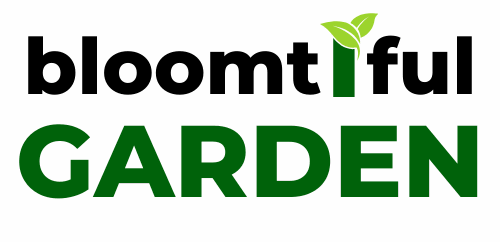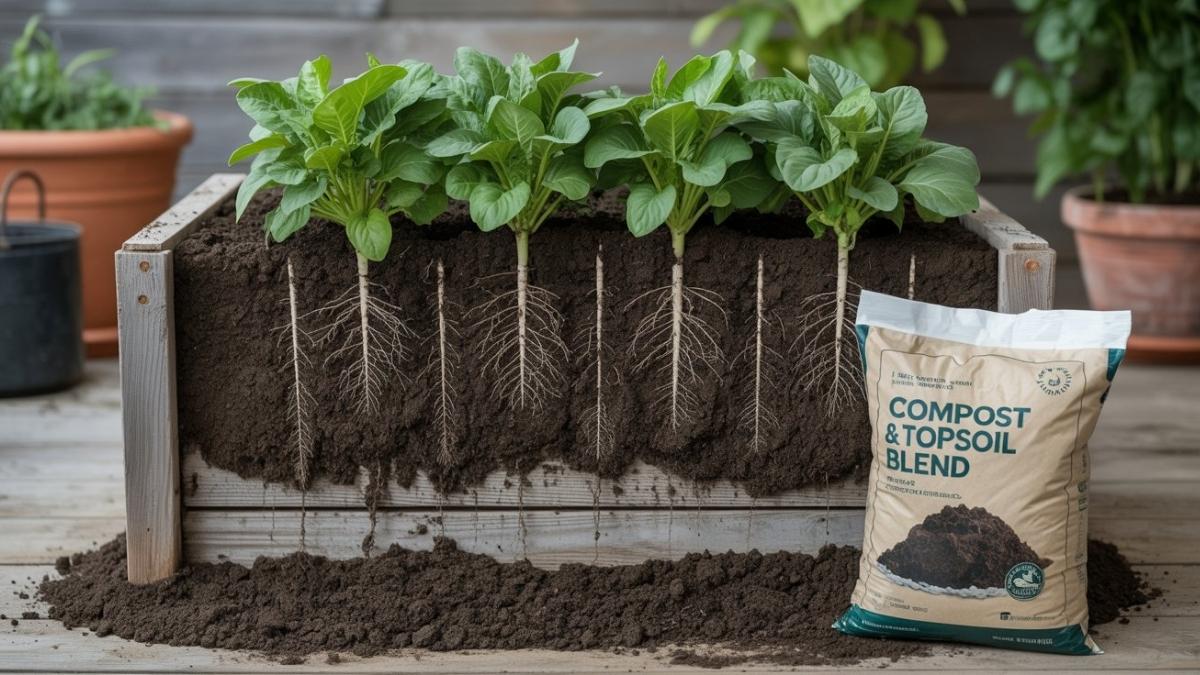Raised bed gardening has emerged as the dominant paradigm for modern residential agriculture, offering a robust solution to poor native soil, physical limitations, and the aesthetic desires of the contemporary homeowner.
The market data surrounding this horticultural shift is staggering; the global raised garden bed market is projected to reach a valuation of USD 631.57 million by 2034, growing at a CAGR of 3.7%.
This growth is not merely a reflection of a hobbyist trend but indicates a fundamental shift in how urban and suburban populations approach food sovereignty, sustainability, and landscape design.
In the United States alone, the market is expected to hit USD 72.54 million by 2034, driven by a heightened demand for organic, self-cultivated produce.
Material Comparison for Raised Beds
Mistake 1: Site Selection and the Microclimate Oversight
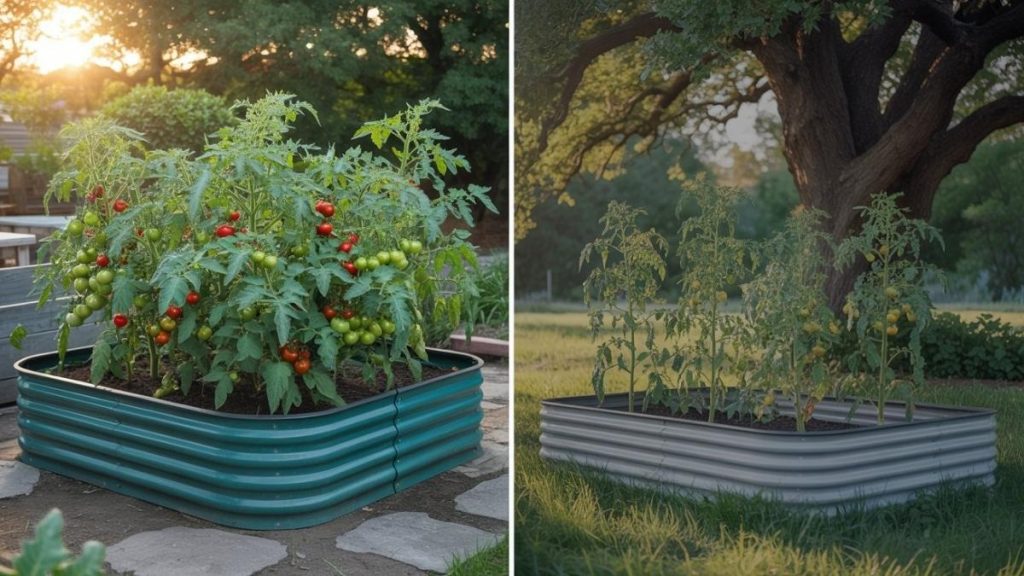
One of the most pervasive errors is selecting a location based on aesthetic integration with the landscape rather than the physiological needs of the crops.
Beginners often prioritize how the beds look from the patio or the kitchen window, ignoring the solar geometry and topographical nuances required for high-yield photosynthesis.
Solar Requirements and Photosynthetic Flux
Vegetable crops, particularly fruiting varieties like tomatoes, peppers, and squash, require a minimum of 6 to 8 hours of direct, unfiltered sunlight daily. The intensity of this light drives the photosynthetic flux density required to produce the sugars necessary for fruit development.
Placing a bed in an area with dappled shade or less than 6 hours of sun typically results in etiolated (leggy) growth, where the plant stretches desperately for light, resulting in weak stems and a failure to set fruit.
However, the nuance of when this sunlight occurs is equally important. In hotter climates or regions experiencing the intense heat waves becoming more common in 2025, afternoon sun can be scorching.
A site that receives morning sun and filtered afternoon shade may actually be preferable for leafy greens to prevent bolting, whereas heat-loving crops demand the full intensity of the midday sun.
Topography and Drainage Dynamics
A critical, often overlooked factor is the existing topography. Beginners frequently place beds in low-lying areas of the yard that are viewed as “dead space” suitable for a garden box.
This is a hydrological error. While raised beds are praised for their drainage capabilities, placing them in a topographical depression creates a “sump” effect.
During heavy rains, the surrounding water table rises, and water can wick upward into the bed through capillary action, leading to anaerobic conditions in the lower root zone.
Conversely, placing beds on steep slopes without terracing or leveling the ground first leads to structural instability. Water will naturally flow to the lowest point of the bed, creating a moisture gradient where plants at the top are perpetually drought-stressed while plants at the bottom suffer from root rot.
For gardeners dealing with sloped terrain, such as the terraced hillsides common in regions like West Virginia, the bed must be leveled across its width to ensure uniform water distribution.
The “Convenience” Factor and Maintenance Friction
There is also a psychological component to site selection. A common mistake is placing the garden in a remote corner of the property to “hide” the mess. Horticultural research suggests that proximity to the home correlates strongly with maintenance frequency.
The “out of sight, out of mind” phenomenon is a primary driver of neglect; a garden that is visible from the kitchen or near a frequently used path is far more likely to be weeded and harvested regularly.
Analyst Recommendation: Before installation, perform a “sun mapping” exercise, observing light patterns at 9:00 AM, 12:00 PM, and 3:00 PM. Orient beds on a North-South axis to ensure equal light distribution across the canopy, minimizing the shading of smaller plants by larger ones.
Mistake 2: Excessive Bed Width and Ergonomic Failure
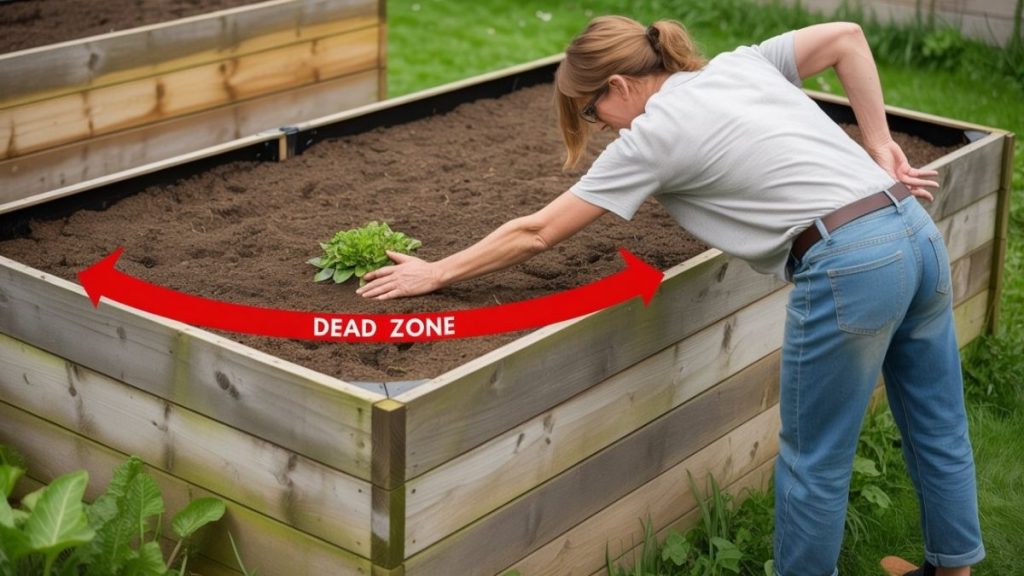
The “Ergonomic Fallacy” occurs when gardeners build wide, expansive beds to maximize planting area, inadvertently creating a maintenance nightmare that compromises soil health.
The 4-Foot Maximum and Anthropometry
Horticultural extension standards universally recommend a maximum width of 4 feet for beds accessible from both sides, or 2 feet for beds placed against a wall or fence. This dimension is strictly derived from average human anthropometry: the average functional reach of an adult is approximately 24 inches.
The consequence of ignoring this rule is severe. If a bed is 5 or 6 feet wide, the gardener cannot reach the center to weed, plant, or harvest without physically stepping into the bed.
Stepping into the bed exerts hundreds of pounds of pressure per square inch on the soil, causing immediate compaction. This negates the primary biological advantage of raised bed gardening, which is the maintenance of loose, friable soil structure that never requires tilling.
Length and Linear Logistics
While the width is constrained by the human arm, the length of the bed is variable. However, beds that are excessively long—exceeding 12 feet—can create logistical friction. If a gardener has to walk all the way around a 20-foot bed to get to the other side, they are likely to step over or through it eventually.
To mitigate this, longer beds should be broken up with “catwalks” or traverse paths to facilitate easy movement across the garden space.
Ergonomic Benefits for Aging Populations
The raised bed market is increasingly serving an aging demographic. One of the profound benefits of a properly dimensioned raised bed is the ability to sit on the edge while working, reducing back strain.
This benefit is lost if the bed is too wide, forcing the gardener to lean excessively or stand to reach the center. Trends for 2025 indicate a rise in “accessible gardening” designs, where bed height and width are specifically tuned to allow for gardening from a seated position or a wheelchair.
Mistake 3: Inadequate Pathway Width and Infrastructure Bottlenecks

A garden is not just a collection of boxes; it is a logistical network that requires the movement of people, tools, and materials. Beginners frequently underestimate the space required for this movement, prioritizing growing space over infrastructure and designing paths that are a mere 12 to 18 inches wide.
The Mechanics of Access and Tool Clearance
Functional analysis suggests that the absolute minimum pathway width should be determined by the widest tool used in the garden—typically a wheelbarrow or a garden cart. Standard wheelbarrows require a minimum clearance of approximately 19 to 24 inches just for the legs and wheel.
However, this leaves no margin for error. If a path is exactly the width of the wheelbarrow, the gardener will inevitably scrape their knuckles or damage the corners of the beds while maneuvering heavy loads of soil or compost.
A functional, comfortable width for maneuvering, crouching to weed, and moving equipment is 3 to 4 feet. This allows for a wheelbarrow to be turned or set down without blocking the entire path.
Pedestrian Compaction and Edge Effects
Narrow paths create a secondary problem known as “pedestrian compaction.” When a path is too narrow, the gardener is forced to walk on the very edge of the pathway, often stepping on the edge of the soil within the bed itself.
Furthermore, the soil under the pathway becomes extremely compacted. If the path is too close to the plants, this compaction zone can encroach upon the root zones of the marginal plants, restricting their access to oxygen and water.
Accessibility Standards
For aging gardeners or those using mobility aids—a growing demographic in the “lifestyle gardening” sector—paths must be wider. A standard wheelchair requires a turning radius and clearance that necessitates paths of at least 4 to 5 feet in width.
Designing with these dimensions from the outset ensures the garden remains usable long-term, preventing the need for costly retrofitting as the gardener’s physical mobility changes.
Mistake 4: Improper Material Selection (Safety, Durability, and Market Trends)
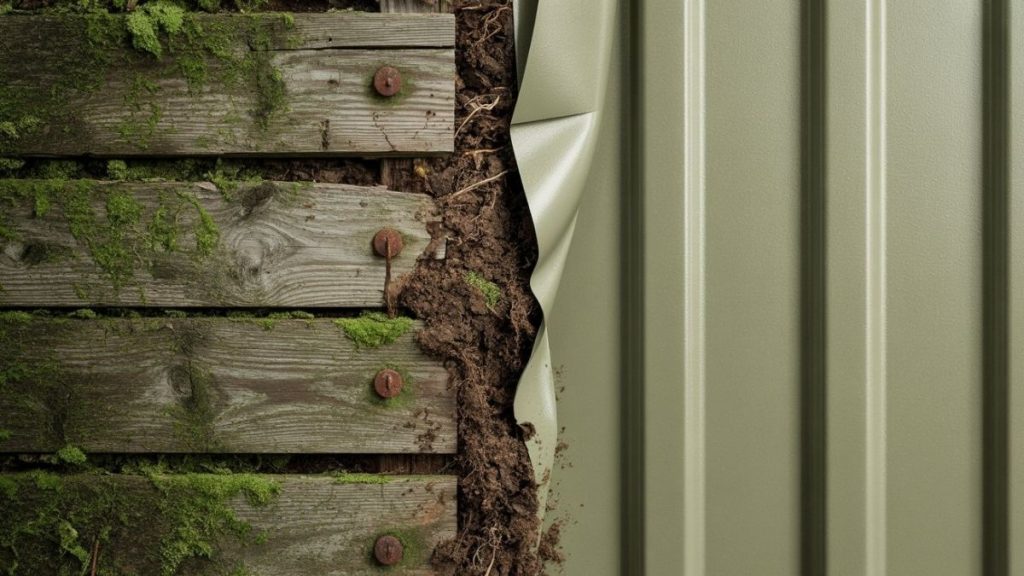
The choice of construction material involves a complex balancing act between cost, aesthetics, longevity, and chemical safety. The 2025 market is witnessing a decisive shift away from traditional lumber toward metal and composite materials, driven by sustainability concerns and long-term economic analysis.
The Treated Wood Controversy and Chemical Leaching
Historically, pressure-treated lumber was preserved with Chromated Copper Arsenate (CCA), a chemical cocktail that posed a documented risk of arsenic leaching into the soil and subsequent uptake by root vegetables.
While CCA was phased out for residential use, modern pressure-treated wood typically uses copper-based preservatives such as Alkaline Copper Quaternary (ACQ) or Copper Azole. While these are safer than arsenic, they still introduce heavy metals into the soil ecosystem.
If a gardener chooses to use treated wood, extension services recommend lining the bed with a heavy plastic or landscape fabric to create a barrier between the wood and the soil. However, this adds complexity and creates a potential trap for moisture between the liner and the wood, accelerating rot.
Conversely, using untreated softwoods like pine or fir is an economic trap; while the initial cost is low, these woods will rot in contact with moist soil within 3 to 5 years, requiring complete replacement.
The Rise of Aluzinc and the Metal Bed Revolution
A significant trend for 2025 is the massive adoption of metal raised beds, particularly those made from Aluzinc (an aluminum-zinc alloy). Market analysis projects that the metal raised bed segment is growing rapidly, holding a 29% market share and favored by 44% of commercial growers for its longevity.
Aluzinc steel beds offer a lifespan of 20+ years, resisting rust and rot far better than wood or standard galvanized steel. They are also modular, allowing gardeners to change the shape of the bed (e.g., from a rectangle to an L-shape) as their needs change.
Thermodynamics: Busting the Overheating Myth
A common fear among beginners is that metal beds will overheat plant roots in the summer. Research and field testing have debunked this. While the metal surface itself can become hot to the touch, the soil mass possesses high thermal inertia.
Furthermore, the high albedo (reflectivity) of light-colored metal beds, combined with the evaporative cooling of the moist soil, prevents root zone temperatures from reaching lethal levels.
In one study, soil temperatures in raised beds were found to be more stable than expected, and in cooler climates, the conductivity of the metal is a distinct benefit, warming the soil earlier in spring to extend the growing season.
Alternative Materials
For those seeking eco-friendly or low-cost alternatives, other materials are gaining traction.
Straw bales can be used as a temporary, biodegradable frame that decomposes into compost over the season. Concrete blocks offer durability and high thermal mass but can be alkaline, potentially altering the soil pH over time.
Mistake 5: Incorrect Soil Composition and the “Potting Soil” Trap
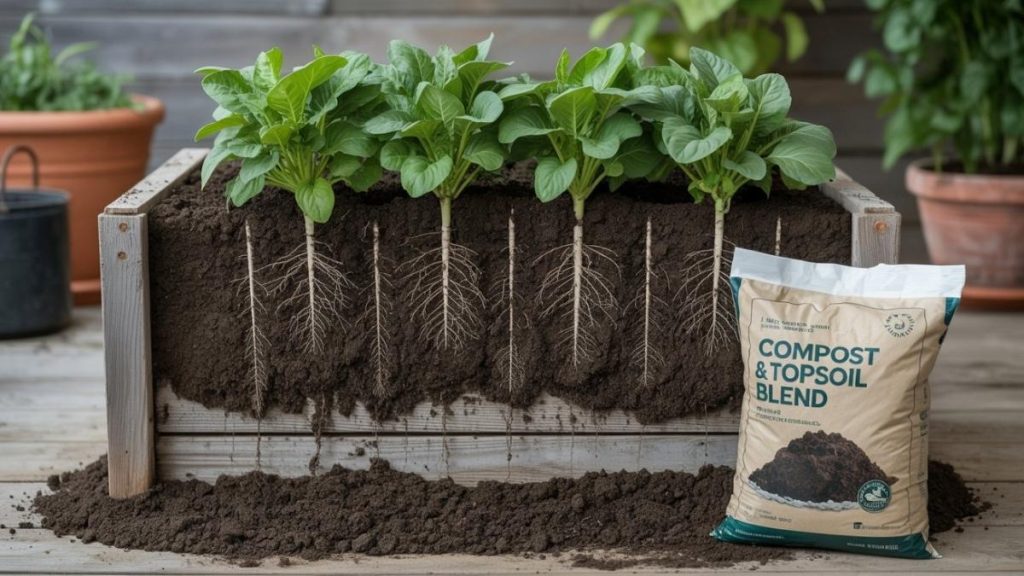
The most fundamental biological error is filling a raised bed with the wrong substrate. This usually manifests in two extremes: filling the bed entirely with bagged potting soil or filling it entirely with native topsoil.
The Potting Soil vs. Garden Soil Dichotomy
100% Potting Soil: Bagged potting mix is typically a “soilless” medium, composed primarily of peat moss, vermiculite, and forest products. While it is light and fluffy, it lacks mineral structure. Over a single season, the organic matter oxidizes and decomposes, causing the bed level to drop by 20–40%.
This rapid subsidence exposes the upper roots of plants and requires expensive annual replenishment. Furthermore, without a mineral component, these mixes dry out with extreme rapidity in a raised environment.
100% Native Soil: Conversely, digging up clay or heavy loam from the yard and placing it in a box usually results in a concrete-like slab. Without the freeze-thaw cycles and deep worm activity of the natural earth, garden soil in a confined box settles and compacts, suffocating roots and preventing drainage.
The Ideal Mix: The 70/30 Rule
University extension services and soil scientists recommend a blend often cited as 70% quality topsoil (the mineral component providing sand, silt, and clay for structure) and 30% high-quality compost (the organic component for nutrients and microbial life). This blend mimics a “loam” texture—the holy grail of agriculture.
To test if a soil mix is correct, gardeners can use the “hand squeeze” test: take a handful of moist soil and squeeze it. It should hold its shape (indicating structure) but crumble easily when poked (indicating friability). If it stays in a tight ball, it has too much clay; if it falls apart immediately, it is too sandy or organic.
Economic Considerations
The cost of filling a raised bed can be shocking. For a 4x8x1 foot bed, you need approximately 32 cubic feet (over 1 cubic yard) of soil. Buying this in bags is prohibitively expensive.
Sourcing bulk soil is cheaper, but quality varies. Interestingly, some gardeners utilize chicken manure as a cost-effective amendment, as it is significantly cheaper by volume than potting soil.
However, this must be composted first, as “hot” manure can burn plants. It should be mixed thoroughly at a rate of no more than 20% to prevent nitrogen toxicity.
Mistake 6: Soil Compaction (The Bulk Density Issue)
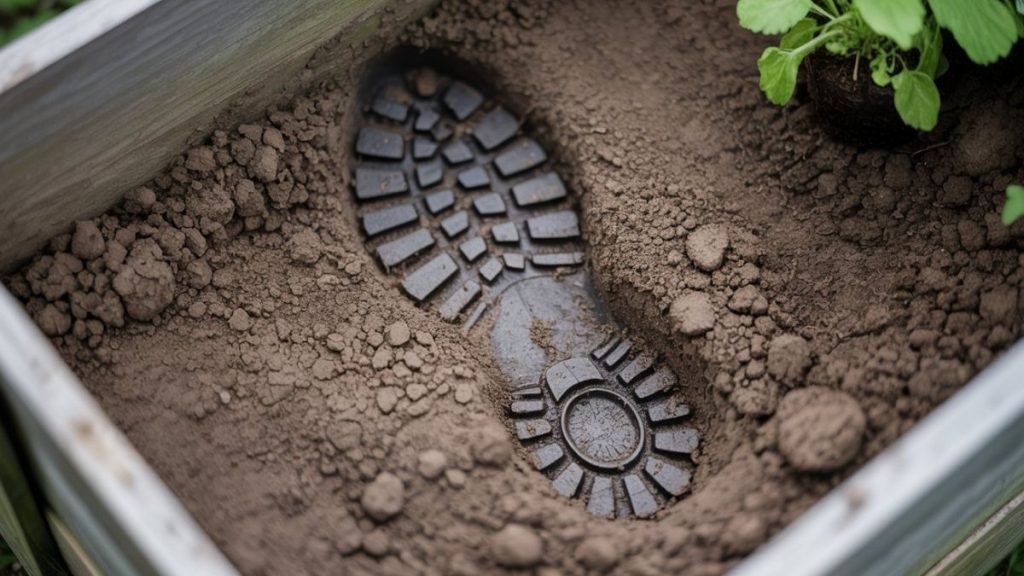
Compaction is the silent killer of raised bed productivity. It is physically defined by “bulk density”—the weight of soil in a given volume.
The Physics of Roots and Pore Space
Plant roots require pore space to move and breathe. A healthy soil matrix is approximately 50% solid matter and 50% pore space (half filled with air, half with water). When a gardener steps on the soil, they collapse these pores, effectively squeezing the air out of the system.
Critical Thresholds: Uncompacted soil has a bulk density of roughly 1.0–1.3 g/cm³. When bulk density exceeds 1.4–1.6 g/cm³, root penetration is mechanically impeded.
The roots physically cannot push through the dense matrix, leading to stunted plants that are incapable of reaching water or nutrients.
Hydraulic Consequence: Compacted soil loses its “macropores,” which are responsible for drainage and air exchange. This leads to waterlogging and root rot, even if the bed is raised.
The compaction forms a barrier that water cannot penetrate, causing runoff on the surface while the soil inches below remains bone dry.
The “No-Step” Philosophy
The primary biological advantage of a raised bed is that it creates an environment where the soil never needs to be tilled because it is never walked on. This preserves the “soil aggregates”—the small crumbs of soil held together by microbial glues that create the pore spaces.
Once these aggregates are crushed by foot traffic, the soil structure is destroyed and turns into a brick-like substance. The rule is absolute: Never walk in a raised bed.
Mistake 7: Inefficient Irrigation (Hand Watering vs. Drip)
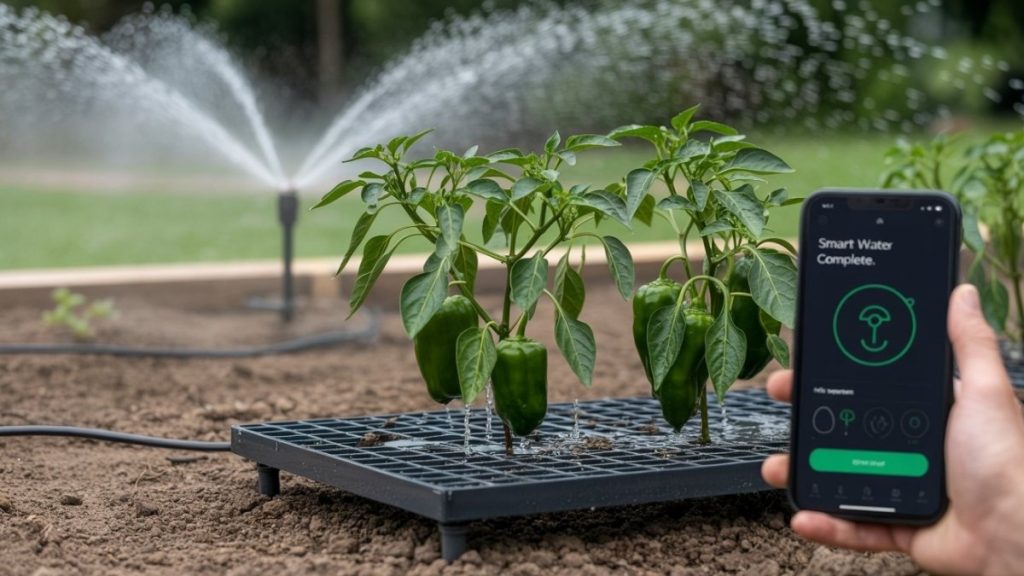
Watering is often viewed by beginners as a meditative chore rather than a precision delivery system. Consequently, many rely on hand-watering with a hose or using overhead oscillating sprinklers. In the context of a raised bed, this is highly inefficient and potentially damaging.
The Efficiency Gap
Hydrological data indicates that drip irrigation systems are approximately 90% efficient, meaning 90% of the water applied reaches the root zone. In contrast, hand watering and overhead sprinklers have an efficiency of only 50–70%.
Evaporation and Runoff: Overhead watering loses significant volume to evaporation before the droplets even hit the soil, especially in the windy conditions often found around elevated beds.
Furthermore, high-volume delivery (like a garden hose) often exceeds the soil’s infiltration rate. The water hits the surface faster than the soil can absorb it, causing it to run off the sides of the raised bed rather than soaking down to the roots.
Disease Vector: Wet foliage is the primary vector for fungal diseases such as Early Blight and Powdery Mildew. Drip irrigation delivers water directly to the soil surface, keeping the canopy dry and significantly reducing disease pressure.
The Economics of Automation
While the initial setup of a drip system involves a cost (ranging from $300 to $800 for a full garden setup, or considerably less for simple DIY hose kits), the long-term savings are substantial.
By reducing water waste by 30-50%, the system pays for itself in water bill savings over time. Moreover, the time savings are immense; hand watering a substantial garden can take hours per week, whereas a drip system requires zero daily effort once programmed.
The 2025 Smart Water Trend
The integration of technology into the garden is accelerating. Smart irrigation controllers (such as the Orbit B-hyve or Rachio) are becoming standard for 2025. These devices connect to local Wi-Fi and adjust watering schedules based on hyper-local weather data.
If rain is forecast, the controller cancels the watering cycle, preventing the common error of overwatering. They also adjust for soil type and slope, ensuring precision delivery that manual timers cannot match.
For those not ready for full automation, simple hose-end timers offer a viable entry point to ensure consistency.
Rainfall Monitoring
A simple but critical tool often missing from beginner gardens is a rain gauge. Beginners often assume that a light shower has watered their garden, when in reality it may have only wet the top ¼ inch of soil. A rain gauge provides the data needed to know exactly how much supplemental water is required.
Mistake 8: Neglecting Mulch (The Evaporation Error)
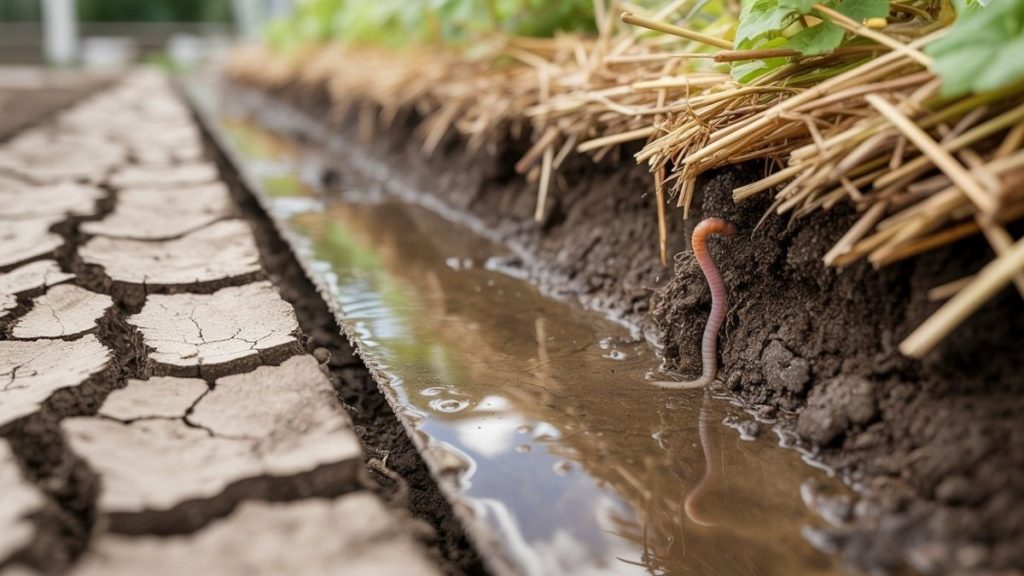
Leaving soil bare is an invitation to failure. Mulch is not merely an aesthetic finish; it is a functional, protective layer of the soil system.
Water Retention Data
Studies on mulching materials demonstrate that mulched soil retains significantly more moisture than bare soil.
In one study comparing different covers, turf-mulched plots retained 127% more moisture than bare sandy soil 24 hours after watering. Even 48 hours later, the mulched plots maintained superior moisture levels.
Thermal Regulation: Mulch acts as an insulator, buffering the soil against temperature extremes. It keeps roots cooler in the summer heat and warmer during cold snaps. Bare soil, by contrast, experiences extreme temperature fluctuations that stress the plant and halt growth.
Erosion Control: Raindrops hit bare soil with significant kinetic energy. This “splash erosion” destroys the soil surface structure, breaking apart aggregates and creating a crust that seals the surface.
This crust prevents future water infiltration, leading to runoff. A layer of mulch absorbs this kinetic energy, preserving the soil’s intake capacity.
Weed Suppression: A 3-inch layer of mulch blocks sunlight from reaching the soil surface, preventing the germination of weed seeds. This is critical in raised beds, where the fertile soil is a prime target for wind-blown weeds.
The “Black Compost” Warning
A common mistake is using compost as a mulch (top dressing) and expecting it to retain water. Research indicates that dark, black compost on the surface absorbs solar radiation, heating up significantly. It can also wick moisture out of the underlying soil through capillary action, increasing evaporation rates.
In trials, compost mulch dried out faster than other materials. Coarse materials like bark chips, straw, or shredded leaves are superior for the top armor layer.
Mistake 9: Overcrowding Plants (The Density Paradox)
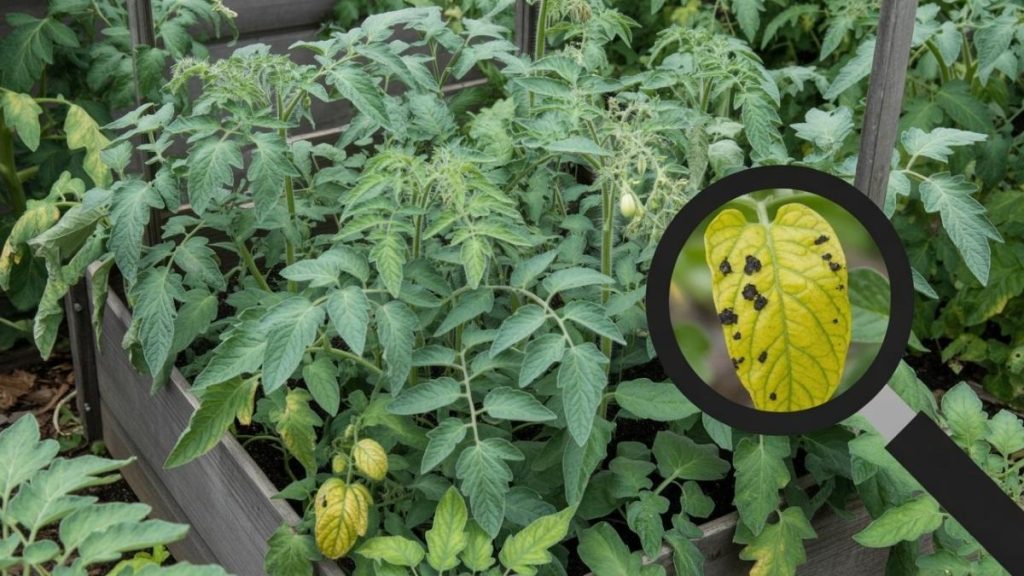
Driven by the desire to maximize yield in a small space, beginners often plant too densely. This is the “Square Foot Gardening” concept taken to a detrimental extreme.
The Disease-Density Correlation
While raised beds allow for intensive planting, plants still require airflow. Overcrowding creates a humid microclimate within the leaf canopy that prevents leaves from drying off after dew or rain.
This environment is perfect for the germination of fungal spores. Diseases like Early Blight in tomatoes thrive in these stagnant, humid conditions.
Root Competition: Plants compete for limited nutrients and water. When tomatoes are spaced less than 24 inches apart, they may produce lush foliage but significantly fewer fruits due to resource stress.
The plant senses the competition and shifts energy allocation away from reproduction (fruit) to survival (vegetative growth).
Data on Spacing: Research on tomato yields indicates that proper spacing (increasing from 20cm to 40cm intra-row) significantly affects fruit size and marketable yield.
While you might get more tomatoes by cramming plants together, you will likely get smaller, lower-quality fruit and a higher rate of disease.
Mistake 10: Insufficient Soil Depth for Crop Type
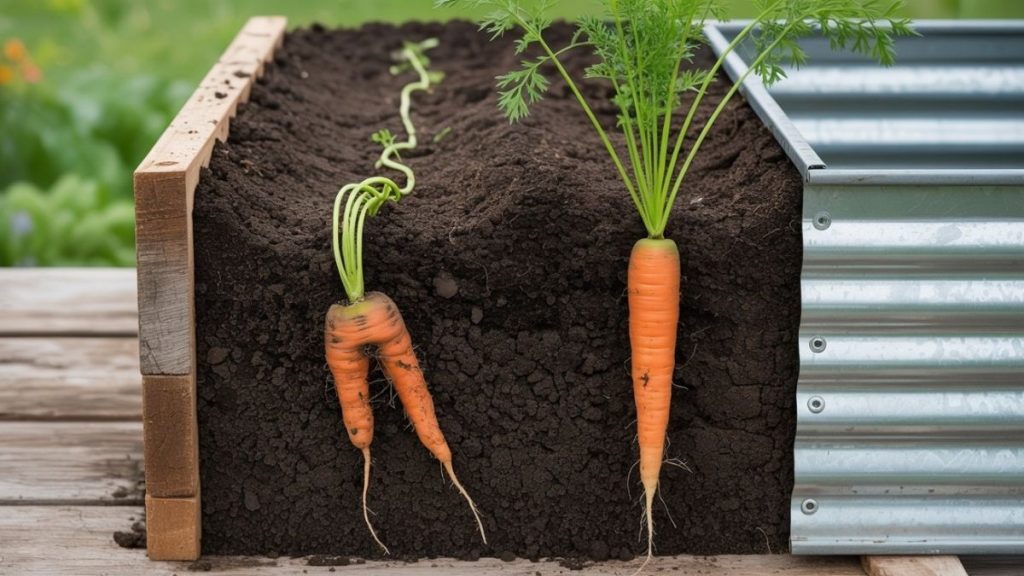
Not all crops have the same root architecture. Building a standard 6-inch bed restricts what can be successfully grown, yet this is a common starting depth for pre-fabricated kits.
Root Depth Requirements
While a 6-inch bed is sufficient for shallow-rooted crops like lettuce, spinach, and many herbs, it is inadequate for heavy feeders and taproot crops.
Tomatoes and Peppers: These plants are deep rooters. Tomatoes, in particular, can send roots down 2-3 feet if the soil allows. In a shallow bed, they hit the native soil barrier (often compacted clay) and become root-bound.
Extension services recommend a minimum depth of 18–24 inches for optimal tomato health.
Root Vegetables: Carrots and parsnips require deep, loose soil to grow straight. If a carrot taproot hits a hardpan at 6 inches, it will fork or stunt. Long carrot varieties require at least 12 inches of friable soil.
Water Holding Capacity: There is also a hydrological advantage to depth. Deeper beds (17–32 inches) hold a larger reservoir of water, making them more drought-resistant.
Shallow beds have less thermal mass and less water storage, meaning they dry out rapidly in the summer heat, requiring daily or twice-daily watering.
Mistake 11: Ignoring Soil Temperature and Seasonality
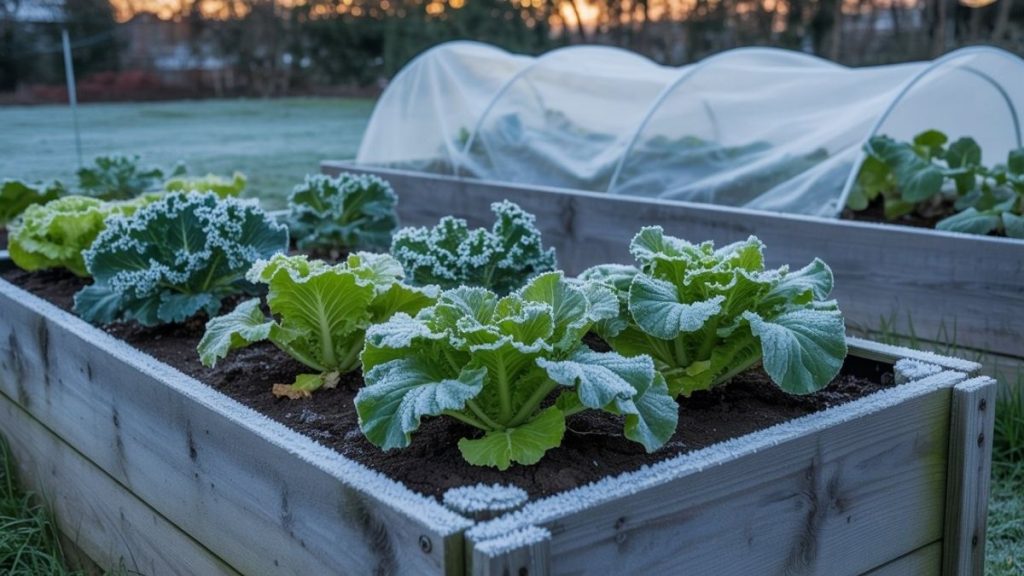
Raised beds have different thermal properties than in-ground gardens. They are biologically active sooner in the spring but are more vulnerable in the winter.
The Thermal Advantage and Risk
Spring: Raised bed soil can be 8–13°F warmer than the ground soil in early spring. This is because the sides of the bed are exposed to the sun, and the soil drains better (dry soil warms faster than wet soil).
Beginners often fail to take advantage of this “early start” window, waiting until the traditional “ground planting” dates to sow seeds, effectively wasting weeks of productive growing time.
Winter: Conversely, because the sides are exposed to cold air, the soil in a raised bed freezes faster and harder than the insulated ground. The “frost line” penetrates from the sides as well as the top.
Overwintering crops (like garlic or perennial herbs) in raised beds requires extra insulation (mulch or row covers) to prevent root death from rapid freeze-thaw cycles.
Mistake 12: Monoculture Planting and Lack of Biodiversity
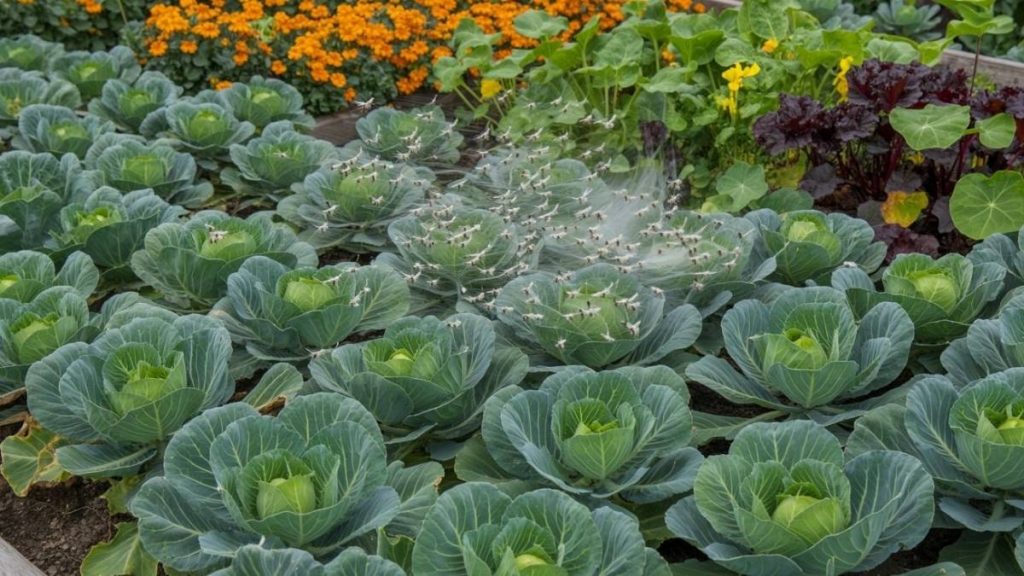
Planting an entire bed with a single crop family (e.g., a “Tomato Bed” or a “Cabbage Bed”) is a biological error that invites disaster.
Pest and Nutrient Dynamics
Pest Concentration: Monocultures act as a beacon for pests. If a bed is filled entirely with brassicas (kale, broccoli, cauliflower), it will attract cabbage loopers and aphids in manageable numbers that quickly become a devastating infestation.
Nutrient Depletion: Different plants have different nutrient demands. Nightshades (tomatoes, peppers) are heavy nitrogen and phosphorus feeders. Growing them exclusively depletes these specific nutrients rapidly.
Rotating crops and mixing plant families ensures a more balanced extraction of soil resources.
The 2025 Trend: Edible Landscapes and Interplanting
Current trends emphasize “edible landscapes” and “wildlife-friendly” gardens. Interplanting flowers (like marigolds, nasturtiums, or alyssum) with vegetables is no longer just for aesthetics; it is a functional pest control strategy.
The flowers attract pollinators and beneficial insects (like ladybugs and parasitic wasps) that prey on garden pests. Furthermore, the diverse scents disrupt the olfactory navigation of pests looking for their host plants.
Mistake 13: Winter Neglect (The Empty Bed)
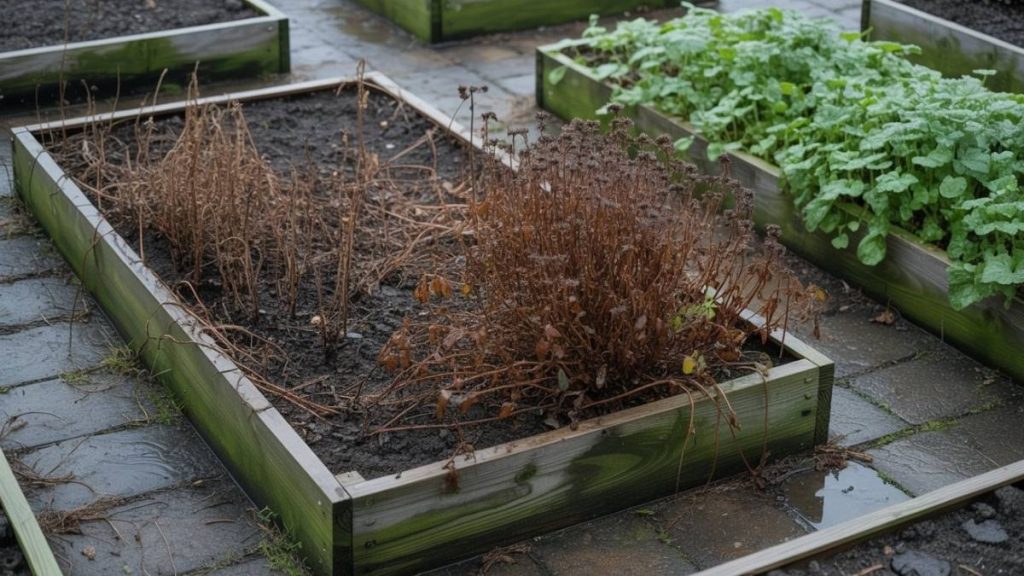
Leaving a raised bed bare and weedy during the winter is a missed opportunity and a detriment to soil health.
The Role of Cover Crops
Nature abhors a vacuum; if you do not plant a crop, nature will plant weeds. Furthermore, leaving soil bare exposes it to winter rains, which leach out valuable nitrogen and cause compaction.
Nitrogen Fixation: Planting a winter cover crop (such as crimson clover, hairy vetch, or Austrian winter peas) serves a dual purpose. First, these legumes form symbiotic relationships with soil bacteria to “fix” atmospheric nitrogen into the soil, essentially growing free fertilizer for the spring planting.
Biomass and Structure: Grass cover crops like winter rye produce massive amounts of root biomass, which helps to break up soil and add organic matter when they decompose.
This practice, known as “green manuring,” is essential for maintaining fertility in closed systems like raised beds without relying solely on chemical fertilizers.
Weed Suppression: A thick cover crop outcompetes winter weeds like chickweed and henbit. Without a cover crop, the gardener faces a labor-intensive weeding session in spring before planting can even begin.
Mistake 14: Reactive Weed Management (The Seed Bank Explosion)
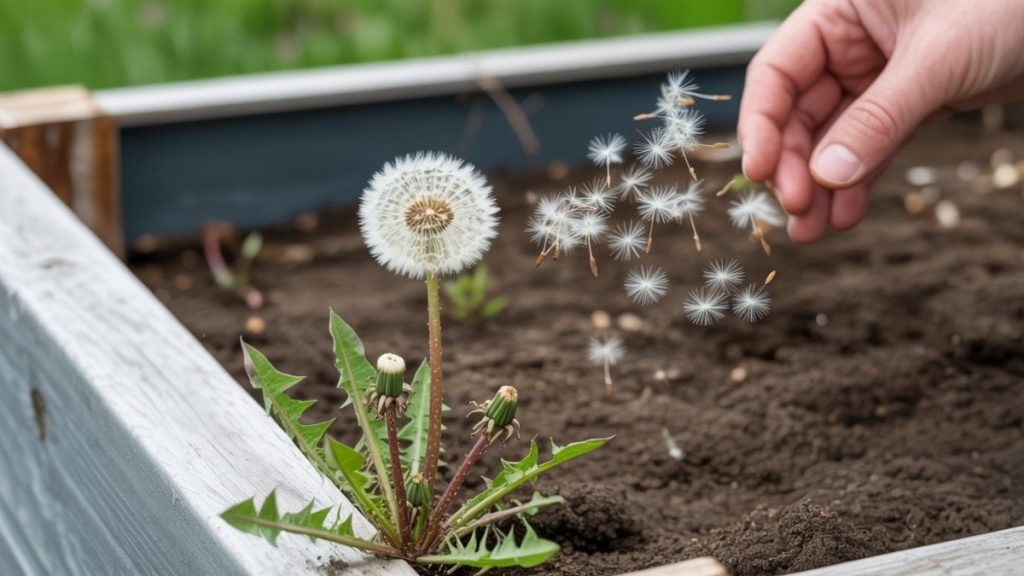
Beginners often wait until weeds are visible and established before acting. By then, the battle is often lost.
The Seed Bank
A single weed plant can deposit thousands of seeds into the soil. Because raised bed soil is fertile, aerated, and irrigated, weeds grow explosively, often faster than the vegetable crops.
The “Weed-Free” Myth: The mistake is assuming raised beds are inherently weed-free. While the initial soil fill may be sterile, wind, birds, and compost introduce seeds constantly.
Proactive Strategy: The most effective strategy is early intervention. Weeds should be removed when they are “threads”—tiny white seedlings just emerging. At this stage, a light scuffling of the soil surface disrupts them.
Waiting until they develop taproots disturbs the soil structure when they are pulled. Furthermore, maintaining a dense planting canopy or using mulch denies light to the soil surface, preventing germination in the first place.
Mistake 15: Overestimating Capacity and Planning Failure (Burnout)
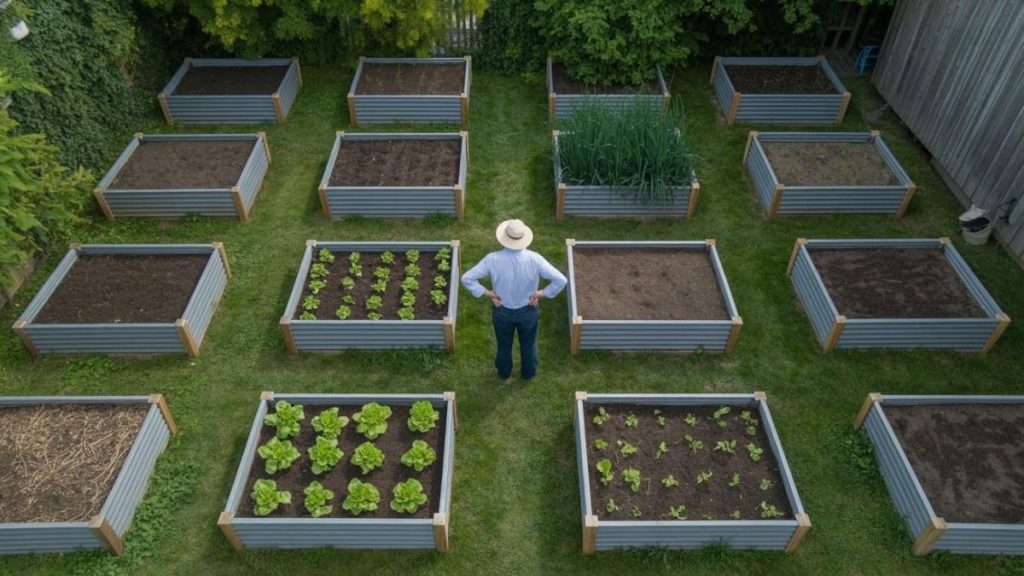
Perhaps the most human error is ambition exceeding capacity. Building five raised beds in the first year often leads to a maintenance crisis in July.
The Psychology of the “Quit Rate”
Gardening requires consistent, low-intensity effort. A large garden that becomes overgrown triggers a psychological response of guilt and avoidance.
The gardener feels overwhelmed, stops visiting the garden, and the “neglected box of dirt” becomes a monument to failure. This is a primary contributor to the 40% first-year quit rate.
Smart Planning and Technology
Start Small: It is far better to have one perfectly maintained 4×8 bed that yields a bounty of salad greens than five neglected beds that produce only stress. Success in a small space builds the confidence and skills required to expand in subsequent seasons.
Tech-Assisted Management: Utilizing reminder apps and AI-driven garden planners (a key 2025 trend) can help manage the schedule. These tools track planting dates, predict harvest windows, and remind the gardener when to fertilize or water, reducing the mental load of management.
This digital assistance helps bridge the gap between the desire for a garden and the discipline required to maintain it.
Conclusion: Cultivating Success
The transition from a novice to a successful gardener lies in shifting one’s perspective from “installing a product” to “managing an ecosystem.” A raised bed is not merely a wooden or metal box; it is a vessel for a complex biological interplay between soil structure, water dynamics, and plant physiology.
By avoiding these 15 mistakes—specifically by prioritizing soil physics (preventing compaction), investing in efficient hydrology (drip irrigation), and respecting the spatial and solar requirements of plants—the gardener drastically increases the probability of a bountiful harvest.
The trends for 2025 reinforce this approach, moving toward durable materials and smart technologies that assist in maintaining these optimal conditions. The successful raised bed garden is one where the science of horticulture supports the art of growing, transforming a backyard plot into a sustainable, productive, and enduring source of food and beauty.
